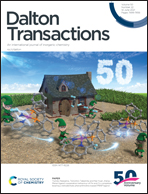Proton conductivity in mixed cation phosphate, KMg1−xH2x(PO3)·yH2O, with a layered structure at low-intermediate temperatures†
Abstract
Proton solid electrolytes, which exhibit high proton conductivity at a wide range of low-intermediate temperatures (150–300 °C), are key materials for the development of fuel cells for automobiles and cogeneration systems. In this study, a benitoite-type polyphosphate, KMg1−xH2x(PO3)·yH2O, which has a non-combustible and layered structure, was investigated as a new proton conductor. The benitoite-type KMg1−xH2x(PO3)·yH2O was synthesised by a coprecipitation method. The solid solution formed in the range of x = 0–0.100 in KMg1−xH2x(PO3)3·yH2O. Multi-step weight loss due to dehydration was observed for TG/DTA measurement at 30 °C and 150 °C. We observed enhanced peaks of the vibration bands at around 1117 cm−1 and 1229 cm−1, which were attributed to the symmetric and asymmetric PO2 vibration modes, and at 743 cm−1 and 970 cm−1 due to the ns(P–O–P) and nas(P–O–P) modes as well as broad absorbance peaks at 2300 cm−1 and 2700 cm−1 corresponding to the vibration modes of ns(P–O–H) with increasing x for FTIR spectra, which suggest the introduction of protons to the crystal structure. Proton conductivity increased from x = 0 to 0.10 and then decreased at x = 0.125, where the impurity phase was observed. The sample with x = 0.10 in benitoite-type KMg1−xH2x(PO3)3·yH2O exhibited high proton conductivity of 1.4 × 10−3 S cm−1 at 150 °C and 6.5 × 10−3 S cm−1 at 250 °C under a non-humidified N2 gas flow.



 Please wait while we load your content...
Please wait while we load your content...